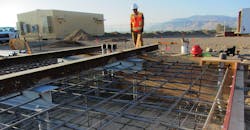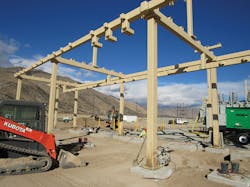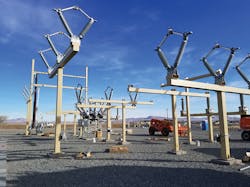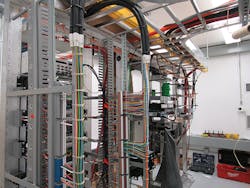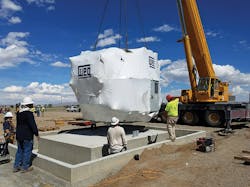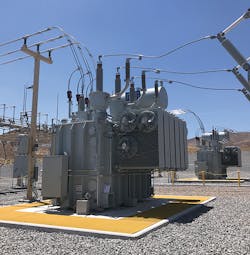NV Energy constructed three substations in the 1960s to serve its communities in the Yerington and Smith Valley areas. As the population continued to grow, the substations could no longer provide the high degree of reliable power expected by its customers.
Fast forward to today, and NV Energy has energized two new substations, a 20-mile, 60 kV transmission line and rebuilt an existing 25 kV distribution line to serve the Yerington and Smith Valley areas. These new assets are helping to improve not only reliability, but also voltage to these agricultural areas by bringing transmission service into Smith Valley, especially during peak times in the summer months.
Focusing on Design and Construction
Constructing a substation is complex and can take years to complete. The process involves acquiring land, securing necessary permits, creating specific designs to meet customer needs, coordinating many moving parts and finally, managing the construction itself.
The design portion alone took the better part of two years to complete. Then a diverse mix of teams and disciplines performed the actual construction. For example, external contractors handled the earth work and bus construction on the substation site.
Next, NV Energy electricians installed and commissioned the substation equipment. The construction part of the project took about eight months to complete, and it required teamwork and participation from many employees, including substation electricians, design engineers, protection and control technicians, telecommunications workers, a transmission lines group and distribution line crews. Other supporting departments included environmental, lands regional engineers, system control and legal support.
During the construction project, the crews had to work in a remote Nevada location for an extended portion of time. Most of the NV Energy crews responsible for the construction lived more than an hour-and-a-half away in the Reno, Nevada, area. To meet construction deadlines and reduce costs associated with travel times, many crews were temporarily relocated closer to the job site during construction. For the Smith and Mason Valley projects, eight electricians were out of town for almost four months, which was the most significant challenge faced during the construction phase.
Decommissioning the Old Substations
In addition to constructing two new substations, the crews now plan to decommission the old, legacy substations. The demolition of a substation is often just as involved as the construction of a new substation.
One of the first steps is to assess every piece of equipment and determine how it should be handled. Newer equipment may be kept and used as a spare for future emergencies. Meanwhile, older equipment may be salvaged for any useful or unique parts potentially needed in the future. Finally, unwanted equipment will be salvaged and recycled.
After the substation equipment is removed, the company’s general construction department will remove the perimeter fences and any remaining below-grade cable facilities, resorting vegetation to the site.
Building New Lines
The work crews not only constructed the two new substations, they also constructed a 60kV transmission line in the same location as the existing 25kV distribution line to reduce the impact to the environment.
Whenever the existing distribution route crossed through the middle of private property, NV Energy worked with the landowners to reroute the line along their property boundaries to allow them full use of their property. Since it is an agricultural area, landowners are now able to use entire fields for crops instead of just portions.
To continuously serve customers in Smith Valley, the linemen crews had to build the new transmission line with the distribution system fully energized. The customers experienced short, planned outages to cut over their services. Now, even when electric usage is high, especially during the summer irrigation season, the new assets are improving voltage and reliability in these areas.
When constructing a new substation, safety is always NV Energy’s number-one concern. Its electricians complete extensive safety training so they can work safely around the high-voltage equipment found in substations.
In addition to working safely, employees are also expected to use the company’s human performance improvement error prevention tools. For example, NV Energy teaches its employees to identify and eliminate error traps, to be aware of their surroundings and to use tools such as peer checking and three-part communications to help eliminate errors.
Finally, NV Energy builds its new substations to a well-defined standard. This helps with reliability, reduces the cost of spare equipment and parts and allows crews the ability to restore power to customers faster in the event of an equipment failure.
Safeguarding the New Substations
Another consideration during the construction of the substations was security. To protect the equipment, the majority of the conductor used inside the substation is aluminum. This was done to help deter anyone from entering the substation to attempt to steal visible copper conductor.
NV Energy also installed security systems at the substations to enhance remote monitoring with real-time information. The company’s corporate security department monitors the substations 24 hours a day. It can respond to an incident before an assailant has the opportunity to damage any of the equipment located inside the substations.
Installing New Technologies
NV Energy’s two new substations are filled with new technologies, such as state-of-the-art microprocessor-based relays, which allow for better reliability. Engineers are now able to download event reports and analyze faults to help identify the cause of an outage.
As far as the substation equipment, crews constructed what is called a ring bus at the Mason Valley Substation for the purpose of increasing reliability. The new configuration allows the company to isolate specific pieces of equipment in the substation and reduces outages for customers. For example, if a problem surfaces with one of the two transformers at Mason Valley, crews can isolate that transformer and troubleshoot the problem while leaving the rest of the substation energized. In the past, when one of the legacy substations experienced a problem, every customer served from that substation would be without power until the issue was resolved.
NV Energy also implemented another design feature at Smith Valley and Mason Valley substations—a main and transfer distribution bus. The addition of the transfer bus allows customer loads to be moved from one breaker to another without having to take an outage. The new design allows NV Energy the ability to restore customers to power in case one of the distribution breakers fails. It also enables preventative maintenance to be performed on breakers without taking an outage.
The utility improved reliability in these communities due to the redundancy built into the substation configurations, such as the ring bus at Mason and main-and-transfer at Mason and Smith. Another way that NV Energy boosted reliability is by replacing a distribution service into Smith Valley with a transmission service, which experiences fewer outages. In addition, the substations are now modern and “smart,” allowing for remote access, remote control, event reporting, event analysis and automated fault location reporting.
A third improvement is the addition of extensive bird guarding to protect wildlife. Hawks, owls and other large birds in the Yerington area could be hurt if they fly into the substation equipment. By using bird guards, NV Energy can help to deter birds from entering the substations to eliminate such impacts to wildlife and to keep reliability as high as possible.
Through the installation of new technologies, NV Energy has improved reliability and voltage for its customers. Its new infrastructure, which is now energized and in full operation, has replaced aging assets and can help the utility to prepare for the future.
Kevin Murray ([email protected]) is the supervisor substation operations for NV Energy.
Devon Kendall, PE ([email protected]) is a transmission and civil engineer for NV Energy.
About the Author
Kevin Murray
Kevin Murray is the supervisor substation operations for NV Energy.
Devon Kendall
Engineer
Devon Kendall is an engineer in NV Energy’s transmission and civil engineering department. He has been with the company for two years.
